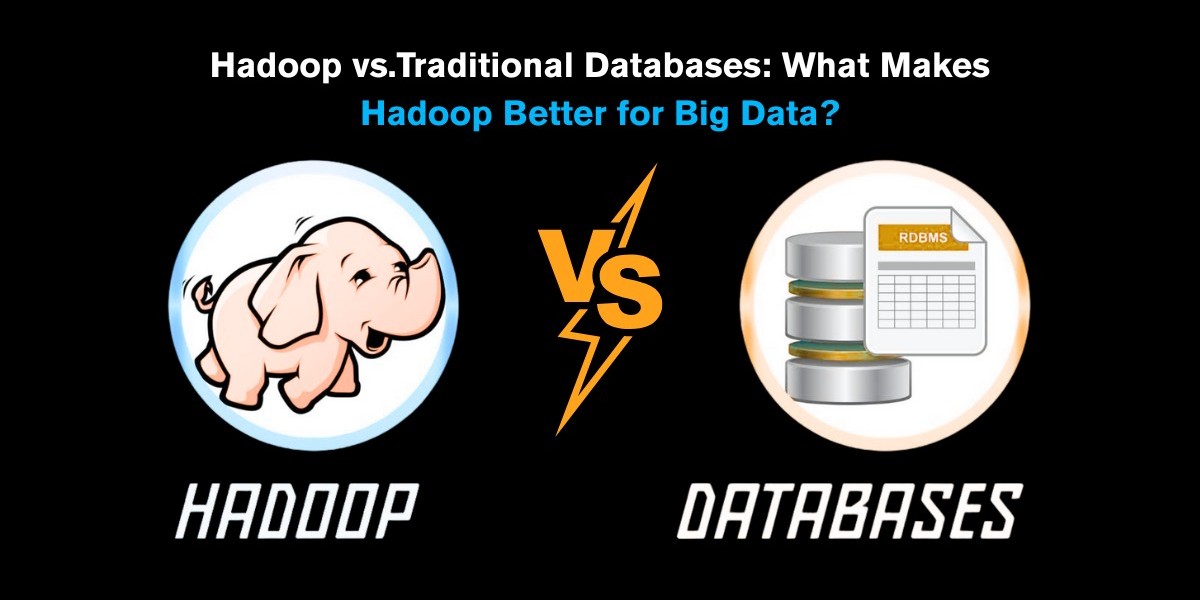As data volumes continue to grow, the tools to manage and analyze them must evolve. Traditional databases, while still useful for many applications, struggle to meet the demands of modern big data environments. Hadoop has emerged as a leading solution for large-scale data processing. This article explains the core differences between Hadoop and traditional databases and why Hadoop Big Data Services are better suited for handling big data challenges.
What Is Hadoop?
Hadoop is an open-source software framework designed to store and process massive datasets across distributed computing clusters. It handles high data volumes efficiently using simple, low-cost hardware. Hadoop is built for scalability, fault tolerance, and flexibility, making it ideal for organizations dealing with structured and unstructured data in large-scale environments.
1. HDFS (Hadoop Distributed File System):
HDFS is the primary storage layer of Hadoop. It stores large files by splitting them into blocks and distributing them across multiple nodes in a cluster. Each block is replicated for fault tolerance. This approach ensures high availability, efficient storage management, and the ability to process data locally on each node, reducing network bottlenecks.
2. MapReduce:
MapReduce is the processing engine in Hadoop. It works by dividing large computational tasks into smaller sub-tasks (Map phase), then combining the outputs into meaningful results (Reduce phase). These tasks run in parallel across the nodes in the cluster. This method allows Hadoop to analyze large datasets efficiently and quickly without overloading a single machine.
3. Supporting Tools (Hive, Pig, Spark):
Hadoop’s ecosystem includes tools like Hive, Pig, and Spark that expand its capabilities. Hive provides a SQL-like interface for querying data. Pig offers a high-level scripting language for data transformation. Apache Spark supports in-memory processing for faster computations. These tools simplify data interaction and improve performance for complex analytical workflows in big data environments.
What Are Traditional Databases?
Traditional databases, such as MySQL, Oracle, or SQL Server, are based on the relational model. They use structured schemas and store data in tables. These databases are ideal for structured data and transactional workloads, such as banking systems, inventory tracking, or employee management.
They rely on SQL for querying and follow strict consistency and integrity rules, which is excellent for precision but limits flexibility.
Key Differences: Hadoop vs. Traditional Databases
1. Data Type Handling
Hadoop supports structured, semi-structured, and unstructured data formats. It efficiently stores and processes logs, videos, documents, and images. Traditional databases only manage structured data through rigid schemas. This limitation makes them less suitable for today’s data diversity. Hadoop's ability to work with various data types makes it a better fit for modern data environments.
2. Scalability
Hadoop scales horizontally by adding inexpensive machines to a cluster. This method allows seamless expansion as data volumes grow. Traditional databases rely on vertical scaling, which requires costly hardware upgrades. This makes them harder to scale beyond a certain point. Hadoop Big Data Services support efficient scaling without compromising performance or increasing infrastructure costs dramatically.
3. Storage Capacity
Hadoop handles petabytes of data across distributed systems. Its architecture divides data into blocks and stores them across many servers. Traditional databases often depend on a single server or complex sharding, limiting capacity. Expanding storage in such systems is expensive and inefficient. Hadoop offers virtually unlimited storage potential using low-cost servers, making it highly economical.
4. Processing Approach
Hadoop uses batch processing with distributed computing, enabling the handling of large datasets efficiently. It processes data in parallel across multiple nodes. Traditional databases execute queries row by row, which becomes slow as data size increases. Hadoop’s parallel processing model offers faster and more reliable performance for big data analytics and large-scale computation.
5. Cost of Ownership
Hadoop is open-source and runs on commodity hardware, significantly reducing software and hardware expenses. It avoids costly licenses and proprietary systems. Traditional databases often come with high licensing fees and require powerful hardware. The long-term operational cost of Hadoop is lower, especially for businesses processing large datasets regularly or storing diverse data types.
6. Fault Tolerance
Hadoop maintains high reliability by replicating data across multiple nodes automatically. If one node fails, data remains accessible from replicas. This built-in fault tolerance reduces downtime. Traditional databases need manual setup for replication and failover, increasing complexity and failure risk. Hadoop’s distributed architecture ensures continuous data availability during hardware failures or network issues.
Why Hadoop Is Better for Big Data
1. Built for Volume
Big data projects often deal with terabytes or petabytes of data. Traditional databases cannot store or process this amount efficiently. Hadoop Big Data Services allow enterprises to store massive datasets on clusters without performance bottlenecks.
2. Handles All Data Types
Businesses collect logs, images, social media posts, videos, and documents. Traditional systems struggle with these formats. Hadoop processes all types of data without conversion, which saves time and reduces data loss.
3. Distributed Architecture
Hadoop splits tasks and distributes them across many machines. This parallelism speeds up data processing. For example, analyzing web clickstreams for millions of users becomes possible in hours instead of days.
4. Real-Time and Batch Processing
While Hadoop initially focused on batch jobs, tools like Spark now allow near real-time data analysis. Businesses can detect fraud, monitor system performance, or personalize customer experiences using live data.
5. Custom Data Pipelines
Hadoop Big Data Services let organizations design their own pipelines. These can extract, transform, and load data in stages, feeding it into business dashboards or machine learning models.
Common Use Cases for Hadoop
1. Retail and eCommerce
Retailers use Hadoop to track customer behavior, manage inventory, and run recommendation systems. Analyzing purchase patterns and feedback helps improve product offerings and marketing.
2. Healthcare
Hospitals use Hadoop to store and analyze patient records, scan images, and clinical notes. Predictive analytics help in early disease detection and resource planning.
3. Finance
Banks and financial institutions use Hadoop for fraud detection, transaction monitoring, and risk management. Real-time alerts prevent losses and improve compliance.
4. Telecom
Telecom operators analyze call data records and network logs to optimize service delivery. Hadoop helps manage massive daily data flows.
5. Manufacturing
Manufacturers use Hadoop to analyze machine sensor data and monitor performance. Predictive maintenance helps reduce downtime and costs.
Technical Advantages of Hadoop Big Data Services
Cluster-Based Architecture
Hadoop uses a cluster-based architecture, allowing it to scale from just a few nodes to thousands. As data grows, organizations can add low-cost hardware to the cluster without modifying applications. This architecture ensures efficient distribution of both storage and processing tasks, making Hadoop Big Data ideal for expanding workloads across large, geographically diverse environments.Fault Tolerance
Hadoop is designed with fault tolerance at its core. It automatically replicates data blocks across multiple nodes. If one node fails, the system recovers the data from replicas without manual intervention. This auto-recovery mechanism ensures minimal disruption, high availability, and data protection, which are critical for continuous operations in enterprise-grade big data environments.Open Source
Hadoop is fully open source and free to use, with no licensing fees. This reduces upfront costs for organizations and supports full customization. Developers can modify the framework to meet specific business requirements. Open-source access also encourages community-driven innovation and rapid bug fixes, making Hadoop a flexible and cost-effective solution for big data processing.Extensive Ecosystem
Hadoop includes a wide range of supporting tools that extend its capabilities. Hive enables SQL-like querying. Pig allows data transformation using scripting. HBase supports NoSQL storage, while Spark delivers in-memory processing for faster results. This ecosystem supports data analysis, machine learning, and reporting, making Hadoop a full platform for enterprise big data applications.APIs and Integration
Hadoop supports integration with many programming languages and tools through APIs. Developers can use Java for core functions, Python for scripting, and R for statistical computing. These APIs allow custom application development, real-time analytics, and seamless connections to external systems, making Hadoop highly adaptable for diverse business and research needs.
Statistics Supporting Hadoop’s Growth
Enterprise Adoption
Over 80% of Fortune 500 companies now rely on Hadoop or comparable big data frameworks. These organizations use Hadoop for advanced data storage, analytics, and reporting. Its ability to manage complex and growing data needs has made it a key component of enterprise IT infrastructure across industries like finance, healthcare, retail, and telecommunications.Processing Speed
Hadoop clusters can handle extremely large datasets efficiently. In optimized environments, a Hadoop system can process up to 1 petabyte of data in under 90 minutes. This high throughput is achieved through parallel processing across distributed nodes, making it ideal for batch analytics, log processing, and scientific computing on a massive scale.Improved Decision-Making
Businesses that use Hadoop for data analytics report up to 30% improvements in decision-making speed. By enabling faster access to processed data and insights, Hadoop allows teams to respond more quickly to market trends, operational issues, and customer behavior, leading to better strategic planning and increased business agility.Infrastructure Integration
More than 60% of new data system architectures now include Hadoop components. Organizations often combine Hadoop with traditional systems or cloud platforms to build hybrid data infrastructures. This integration supports large-scale data ingestion, transformation, and analysis, making Hadoop an essential part of modern data engineering and architecture strategies.
Limitations of Traditional Databases for Big Data
1. Schema Rigidity
Traditional relational databases operate on fixed schemas that define table structures before data entry. If business requirements change, modifying these schemas demands database redesign and migration. This process is time-consuming, increases system downtime, and raises operational costs. In contrast, Hadoop allows schema-on-read, enabling more flexibility when working with evolving or diverse data formats.
2. Performance Bottlenecks
As data volumes grow, relational databases face significant performance issues. Large queries often result in slow response times due to row-by-row data processing. Indexing improves access speed but becomes less effective at scale. Hadoop avoids these bottlenecks through distributed parallel processing, which maintains performance even when managing terabytes or petabytes of data.
3. Costly Hardware
To improve performance, traditional databases require vertical scaling—adding more memory, faster CPUs, and storage to a single machine. This high-performance hardware is expensive and difficult to upgrade continuously. Hadoop uses commodity hardware for horizontal scaling, allowing cost-effective expansion without reliance on powerful or specialized servers, significantly reducing infrastructure costs.
4. Limited Unstructured Data Support
Relational databases are designed for structured data in table formats. They struggle with unstructured or semi-structured data such as images, videos, audio files, and JSON logs. Handling these data types usually requires separate processing tools or storage systems. Hadoop natively supports various formats, allowing seamless storage and processing of unstructured data in one environment.
Conclusion
Hadoop is not just a new storage system—it is a complete solution for handling massive data workloads. When compared to traditional databases, Hadoop offers better scalability, flexibility, and cost-efficiency. Hadoop Big Data Services allow businesses to extract insights from complex datasets, supporting innovation and smarter decision-making.
For companies handling growing volumes of structured and unstructured data, Hadoop is the better option. Its distributed design, support for all data types, and strong processing capabilities make it a critical part of modern data infrastructure.







